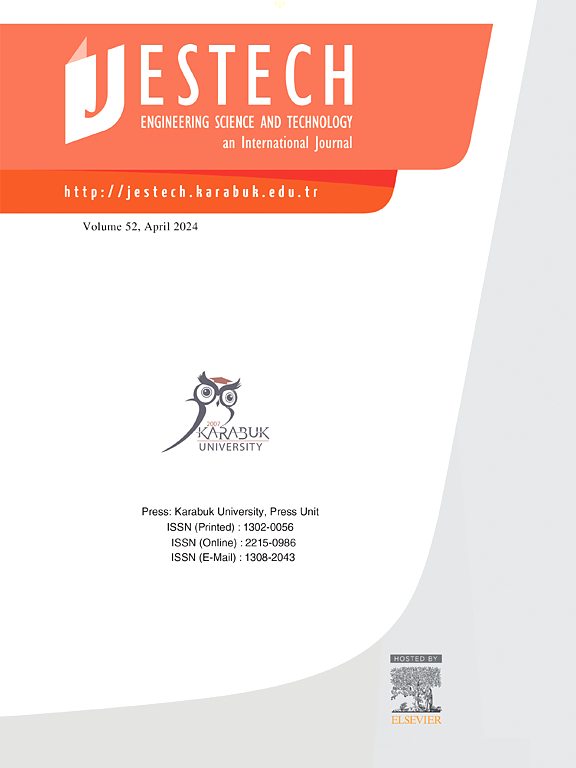Artificial intelligence approach to magnetohydrodynamic flow of non-Newtonian fluids over a wedge: Thermophoresis and Brownian motion effects
IF 5.1
2区 工程技术
Q1 ENGINEERING, MULTIDISCIPLINARY
Engineering Science and Technology-An International Journal-Jestech
Pub Date : 2025-04-25
DOI:10.1016/j.jestch.2025.102071
引用次数: 0
Abstract
The paper deals with the analysis of the laminar incompressible flow of a Carreau-Casson-Williamson fluid having magnetohydrodynamics effects with thermophoresis and Brownian motion effects over a wedge surface. Using similarity variables, a set of coupled ordinary differential equations are formulated for the governing equations of fluid flow. The solution process comprises a two-stage calculation. ODEs are first solved numerically using MATLAB’s bvp4c function, a known solver of boundary value problems known to solve complex ODEs within fluid dynamics very effectively. Further optimization and simplification of the analysis are achieved by using an artificial neural networking base Levenberg Marquardt algorithm (ANN-LMA) model. The derived dataset was divided into three parts: training 70%, validation 15%, and testing 15%. MSE metric between the values of and . MSE values can be used to grade the model’s performance. Increased Weissenberg number increases velocity and elasticity by facilitating flow with the boundary layer. On the other hand, raised Casson, Williamson, and magnetic parameters bring down the velocities as there comes the effect of damping and more resistance. Thermophoresis affects the migration rates of the particles by controlling the thermal and concentration gradient in the boundary layer with Brownian motion influencing its diffusion on the viscosity level and stability of fluid while in motion. In general, there is a fundamental interest in wedge flow because this geometry is present in aerodynamics and hydrodynamics, the study of fluids flowing around shapes like airfoils, nozzles, and underwater vehicles.
非牛顿流体在楔上磁流体动力学的人工智能方法:热泳术和布朗运动效应
本文分析了具有磁流体力学效应、热涌效应和布朗运动效应的carau - casson - williamson流体在楔形表面上的层流不可压缩流动。利用相似变量,建立了流体流动控制方程的一组耦合常微分方程。求解过程包括两个阶段的计算。首先使用MATLAB的bvp4c函数对ode进行数值求解,该函数是已知的边值问题求解器,可以非常有效地求解流体动力学中的复杂ode。采用基于人工神经网络的Levenberg Marquardt算法(ANN-LMA)模型进一步优化和简化了分析。导出的数据集分为三个部分:训练70%,验证15%,测试15%。MSE度量值介于10-8和10-10之间。MSE值可用于对模型的性能进行分级。增加的魏森伯格数通过促进边界层的流动而增加速度和弹性。另一方面,升高的卡森、威廉姆森和磁参数降低了速度,因为有阻尼和更多阻力的影响。热泳通过控制布朗运动边界层的温度梯度和浓度梯度来影响颗粒的迁移速率,从而影响其在运动过程中的扩散,影响流体的粘度水平和稳定性。总的来说,人们对楔形流动有一个基本的兴趣,因为这种几何形状存在于空气动力学和流体动力学中,研究围绕翼型、喷嘴和水下航行器等形状流动的流体。
本文章由计算机程序翻译,如有差异,请以英文原文为准。
求助全文
约1分钟内获得全文
求助全文
来源期刊

Engineering Science and Technology-An International Journal-Jestech
Materials Science-Electronic, Optical and Magnetic Materials
CiteScore
11.20
自引率
3.50%
发文量
153
审稿时长
22 days
期刊介绍:
Engineering Science and Technology, an International Journal (JESTECH) (formerly Technology), a peer-reviewed quarterly engineering journal, publishes both theoretical and experimental high quality papers of permanent interest, not previously published in journals, in the field of engineering and applied science which aims to promote the theory and practice of technology and engineering. In addition to peer-reviewed original research papers, the Editorial Board welcomes original research reports, state-of-the-art reviews and communications in the broadly defined field of engineering science and technology.
The scope of JESTECH includes a wide spectrum of subjects including:
-Electrical/Electronics and Computer Engineering (Biomedical Engineering and Instrumentation; Coding, Cryptography, and Information Protection; Communications, Networks, Mobile Computing and Distributed Systems; Compilers and Operating Systems; Computer Architecture, Parallel Processing, and Dependability; Computer Vision and Robotics; Control Theory; Electromagnetic Waves, Microwave Techniques and Antennas; Embedded Systems; Integrated Circuits, VLSI Design, Testing, and CAD; Microelectromechanical Systems; Microelectronics, and Electronic Devices and Circuits; Power, Energy and Energy Conversion Systems; Signal, Image, and Speech Processing)
-Mechanical and Civil Engineering (Automotive Technologies; Biomechanics; Construction Materials; Design and Manufacturing; Dynamics and Control; Energy Generation, Utilization, Conversion, and Storage; Fluid Mechanics and Hydraulics; Heat and Mass Transfer; Micro-Nano Sciences; Renewable and Sustainable Energy Technologies; Robotics and Mechatronics; Solid Mechanics and Structure; Thermal Sciences)
-Metallurgical and Materials Engineering (Advanced Materials Science; Biomaterials; Ceramic and Inorgnanic Materials; Electronic-Magnetic Materials; Energy and Environment; Materials Characterizastion; Metallurgy; Polymers and Nanocomposites)
 求助内容:
求助内容: 应助结果提醒方式:
应助结果提醒方式:


